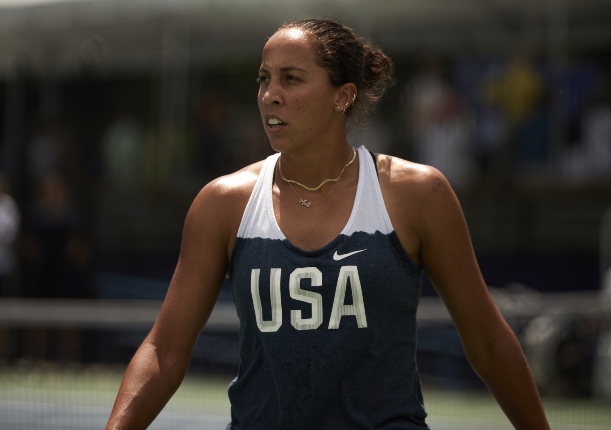
By Richard Pagliaro | @Tennis_Now | Wednesday, April 3, 2024
America will be the world's top tennis nation by 2035—if the USTA achieves an ambitious aim.
The USTA today announced a bold mission: to increase the country’s tennis-playing population to 35 million total players, or 10% of the U.S. population by 2035.
Watch: 5 Reasons We Adore Danimal Collins
That may sound like a stretch given the fact pickleball player growth is surpassing tennis player growth in many areas of the nation.
Then there's the fact Americans are also leading more sedentary lives since the pandemic.
One in eight people in the world are living with obesity, according to The World Health Organization, which ranks the United States 10th in the world for obesity among men, with a male adult obesity rate of 41.6% in 2022.
The U.S. adult obesity rate "increased from 21.2% in 1990 to 43.8% in 2022 for women... placing the country 36th in the world for highest obesity rates among women," according to a WHO study cited by U.S. News and World Report.
Given those statistics and the higher cost of playing tennis compared to other sports like pickleball, basketball and soccer, how does the USTA plan to achieve its ambitious aim over the next decade?
The U.S. Tennis Association strategy includes a dedicated focus on player retention, coaches and courts.
“When players have exceptional experiences, we all succeed. When the delivery system flourishes, tennis grows. At the USTA, our role is to be a connector of excellence across the entire tennis ecosystem,” said Lew Sherr, USTA Chief Executive Officer and Executive Director. “By ensuring players new and old have access to the programs, coaching and facilities they need to progress on their tennis-playing path, we can continue to grow the game and deepen its positive impact — creating new opportunities for human connection and improving the physical, mental and emotional health and safety of our communities, both on and off the court.”
Over the past four years, the USTA says tennis participation in the U.S. has "experienced remarkable growth of 33%, fueled by new players taking up the sport."
This growth stretches across a variety of communities, with participation among Hispanic/Latino players and Black/African-American players "growing by 105% and 63%, respectively, over the past five years — making tennis look more like America than ever before," the USTA asserts.
However, player retention is an issue in America.
Durind the pandemic, tennis player participation rose, however some new players left the game and some experienced players departed tennis in favor of pickleball.
So how does the USTA plan to attract new players and try to persuade lapsed players to return to tennis?
The USTA strategy includes making "a generational investment in strengthening tennis" by:
Creating and scaling programming that keeps new and returning players on the court — for life. By ensuring every player has access to new and existing programming that meets their needs at every step of their journey, the USTA plans to grow the nation’s tennis-playing population to 35 million players — roughly 10% of the total U.S. population. This will include the roll-out of a portfolio of competitive and casual play programs that meet the needs of every age and interest — from young to old, cardio to competitive, and beyond.
Expanding the availability of quality coaching at all levels. To ensure that every player receives the guidance and quality instruction they need, the USTA aims to further raise the standard of coaching and increase the number of available SafePlay-approved coaches to over 80,000 nationwide — including both professional coaches and community-level instructors who provide on-court instruction and facilitation — keeping pace with the goal to grow overall player participation. In doing so, the aim is to get more coaches in parks, public facilities and at schools; provide additional support for volunteers in the roles they choose to play in their communities; and create more viable career opportunities for those who choose to make coaching their profession.
Maximizing court availability to keep pace with participation. Increased player participation requires more courts and more available playable hours on those courts. The USTA plans to deepen its partnership with local governments, parks and recreation facilities, school boards and local clubs to build, renovate and protect tennis facilities across the country, while also seeking to maximize existing infrastructure through enhancements that will extend playable hours and lengthen the tennis season. The goal is to ensure there are 350,000 courts (including both traditional and non-traditional playing spaces) — one for every 100 players — available to help catalyze play in local communities, with a particular focus on underserved areas. As part of this effort, the USTA will support facility operators with the tools they need to run effective, efficient and profitable operations, including programming, technology, data intelligence, coaches and equipment.
Supporting and elevating the next generation of stars. The USTA remains committed to its efforts to develop, support and showcase the best events, players and coaches that U.S. tennis has to offer — empowering up-and-coming competitors to achieve their full potential, and providing a clearer path for our top junior performers to reach the pinnacle of the sport and motivate millions more to follow in their footsteps.

“Tennis is the healthiest sport in the world. In fact, tennis extends our lives by almost 10 years — which is more than any other sport or form of exercise, while improving cognition, psychological well-being, and strength and agility. We can’t let current or future generations miss out on these life-changing benefits,” said Dr. Brian Hainline, USTA Chairman of the Board and President. “Whether it’s the thrill of watching professional play or swinging a racquet on a community court, it’s important to help ensure that communities everywhere have access to the life-enhancing benefits of our wonderful sport.”
Photo credit: Matthew Calvis